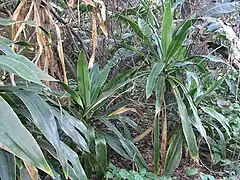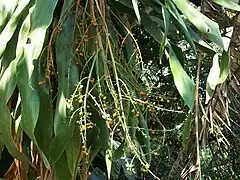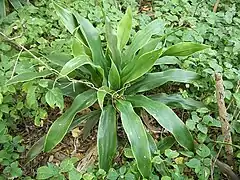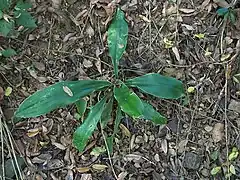Dracaena aletriformis
Dracaena aletriformis is commonly known as the large-leaved dragon tree. These plants are found in forest in the eastern areas of South Africa from Port Elizabeth to northern and eastern Limpopo.[2] They are also found in Eswatini,[2] but are most common in the coastal and dune forests of KwaZulu-Natal.[3]
| Large-leaved dragon tree | |
|---|---|
 | |
| Scientific classification | |
| Kingdom: | Plantae |
| Clade: | Tracheophytes |
| Clade: | Angiosperms |
| Clade: | Monocots |
| Order: | Asparagales |
| Family: | Asparagaceae |
| Subfamily: | Nolinoideae |
| Genus: | Dracaena |
| Species: | D. aletriformis |
| Binomial name | |
| Dracaena aletriformis | |
| Synonyms | |
|
Dracaena hookeriana K.Koch [family DRACAENACEAE] | |
Taxonomy
This plant has 8 synonyms.[1] In the APG III classification system, the genus Dracaena is placed in the family Asparagaceae, subfamily Nolinoideae (formerly the family Ruscaceae).[4] It has also been placed in the Agavaceae (now the subfamily Agavoideae) and the Dracaenaceae. Like many lilioid monocots, it was formerly placed in the family Liliaceae (lily family).[2]
Description
Single stemmed or branched (usually at the base). The leaves are large and strap-shaped in rosettes at the tips of the stem/s. The leaves are leathery, shiny, and dark green, with whitish margins. These plants may grow up to 4 metres (13 ft) tall. The flowers are produced on a much branched flowering head. The flowers are silvery-white and described as sweetly or strongly scented.[3][2] The two-lobed berry-like fruit ripen to a reddish-orange colour.
Ecological significance
The flowers open from late afternoon to early morning and attract night-active pollinator moths. Birds eat the fruit; helping to remove the orange pulp which contains a growth inhibitor that otherwise slows germination of the seeds.[2] Snails and the larvae of the Bush Night Fighter butterfly, Artitropa erinnys, feed on the leaves.[2][5] Birds and mice nest among the leaves of these plants.[3]
Gallery
 A group of D. aletriformis in dune vegetation.
A group of D. aletriformis in dune vegetation. Fruit of D. aletriformis.
Fruit of D. aletriformis. Surrounded by Isoglossa woodii in dune vegetation.
Surrounded by Isoglossa woodii in dune vegetation. A young specimen.
A young specimen.
References
Citations
- "Dracaena aletriformis (Haw.) Bos". Jstor Global Plants. Retrieved 23 September 2020.
- Viljoen 2003.
- Pooley 1993.
- Chase, Reveal & Fay 2009, pp. 132–136.
- Williams, M. (1994).
Sources
- Chase, M.W.; Reveal, J.L. & Fay, M.F. (2009). "A subfamilial classification for the expanded asparagalean families Amaryllidaceae, Asparagaceae and Xanthorrhoeaceae". Botanical Journal of the Linnean Society. 161 (2): 132–136. doi:10.1111/j.1095-8339.2009.00999.x.
- Pooley, E. (1993). The Complete Field Guide to Trees of Natal, Zululand and Transkei. ISBN 0-620-17697-0.
- Viljoen, C. (2003). "Dracaena aletriformis". plantzafrica.com. Retrieved 23 September 2020.